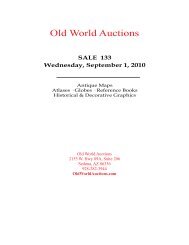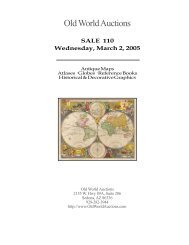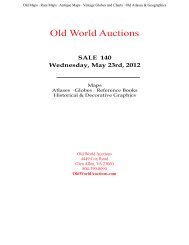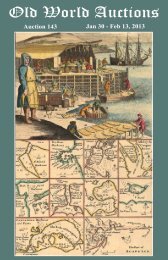PDF catalog - Old World Auctions
PDF catalog - Old World Auctions
PDF catalog - Old World Auctions
Create successful ePaper yourself
Turn your PDF publications into a flip-book with our unique Google optimized e-Paper software.
<strong>Old</strong> Maps · Rare Maps · Antique Maps · Vintage Globes and Charts · <strong>Old</strong> Atlases & Geographies43. <strong>World</strong> ([Lot of 3] Hyetographic or Rain Map of the <strong>World</strong>… [and] Hyetographic or Rain Map of Europe [and] Distribution of Heat Over the Globe), Johnston,The Physical Atlas of Natural Phenomena, ca. 1854. 24.3 x 20.5”. Nice lot of three thematic maps from the English version of Heinrich Berghaus’ PhysikalischerAtlas, the first truly comprehensive thematic atlas. These are very early examples of printed color, the development of which made a huge impact on cartographyin general and specifically on the graphic portrayal of geographical data on thematic maps. Each is surrounded in a keyboard style border.A. Hyetographic or Rain Map of the <strong>World</strong>, hand color. Shows good detail of precipitation levels, with the darker shaded areas indicating the greatest amount ofprecipitation. The map identifies the Sahara and Gobi deserts as the “Rainless District.” At bottom are profile views displaying the varying degree of precipitationby elevation level and proximity to the coastline. Condition: Offsetting and some isolated foxing.B. Hyetographic or Rain Map of Europe, printed color and hand color. Displays precipitation levels for mainland Europe, with the darker shaded areas indicatingthe greatest amount of precipitation. Inset of the British Isles at top right. Condition: There are centerfold separations that extend 1” into the image at top and 1/8”into image at bottom, along with some light offsetting.C. Distribution of Heat Over the Globe, printed color. Impressive sheet demonstrating the surface temperatures of the globe. There are six different maps includingviews of annual average temperature, temperature during winter and summer months, and two hemispheric views at bottom. Condition: There are centerfoldseparations at top and bottom that extend into image 0.75” and 0.25” respectively, and there is light toning along sheet edges. See descriptions. (B+)$200-23044. <strong>World</strong> ([Lot of 2] Map of the Geographical Distribution of the Most Important Plants Yielding Food [and] The Geographical Distribution of Health & Disease, inConnection Chiefly with Natural Phenomena), Johnston, The Physical Atlas of Natural Phenomena, ca. 1854. 24.5 x 20”. (PC) Nice lot of thematic maps fromthe English version of Heinrich Berghaus’ Physikalischer Atlas, the first truly comprehensive thematic atlas. These are very early examples of printed color, thedevelopment of which made a huge impact on cartography in general and specifically on the graphic portrayal of geographical data on thematic maps. Each issurrounded in a keyboard style border.A. Map of the Geographical Distribution of the Most Important Plants Yielding Food, dated 1854. Shows the distribution of grain cultivation across the variousclimatic zones. Includes insets of Europe, the warmer regions of the <strong>World</strong>, and the tea & spice region of Southeast Asia. At bottom are two profile views of showingthe distribution of grains in relation to elevation. Condition: Centerfold separations at bottom and top with the latter just passing the neatline. Faint offsettingwith a hint of toning along the edges of the sheet.B. The Geographical Distribution of Health & Disease, in Connection Chiefly with Natural Phenomena, circa 1854. This fascinating map shows the extent of seriouscontagious diseases during the mid-19th century. The thin red line shows the march of Cholera from east to west and the associated dates of occurrence. Includes4 insets on life expectancy, rheumatism and the fever districts along the eastern United States and West Indies. Condition: There is a long centerfold separation atbottom that has been closed on verso with archival material, some light soiling, and a hint of toning along the edges of the sheet. See descriptions. (B+)$160-20045. <strong>World</strong>, Religion (Mapa de las Religiones de la Tierra), ca. 1874. 12 x 8.3”. (PC) This fascinating color lithograph shows the various religions practiced aroundthe world. A legend at bottom indicates the approximate number of worshipers of each religion and identifies important missions. Engraved by M. Vierge. Light,overall toning and a few faint spots. (B+) $75-10046. Ancient <strong>World</strong> (Secunda Etas Mundi), Schonsperger, Liber Cronicarum, Nuremberg, [1496]. 5.8 x 4”. (BW) This rare woodcut depicting the ancient world isfrom the first edition of the reduced version of Hartman Schedel’s Nuremberg Chronicle, sometimes called the mini-Schedel. The Ptolemaic map, featuring hugerivers and convoluted mountain ranges, is enclosed in a border containing twelve windheads. At three corners are Noah’s three sons, Ham, Shem and Japhet. On afull sheet of Latin text (7.8 x 11”). Much rarer than the folio version, this is a fine example of this charming incunabula map. Ref: Shirley #20; Imago Mundi XI,p. 46. A fine impression with a light damp stain in the bottom left corner of the sheet, far from map. (A) $5500-650047. Ancient <strong>World</strong> ([Daniel’s Dream Map]), Anon., ca. 1564. 6.2 x 4.8”. (HC) This unusual little map is also known as the Wittenberg world map. It representsDaniel’s interpretation of King Nebuchadnezzar’s dream. This prophecy from Chapter 7 of the book of Daniel speaks of “the four winds of the heaven … and fourgreat beasts [which] came up from the sea.” The barely recognizable continents of the <strong>Old</strong> <strong>World</strong> - Europe, Asia and Africa - are depicted with the four beasts ofDaniel’s dream. The world is surrounded by wind heads in a blustery sky and a stormy ocean. Theologians at Wittenberg interpreted this dream as a foretelling ofthe victory of the Turks at the Battle of Mohacs in 1526, and the image remained popular for several decades thereafter. The map first appeared in a commentary onthe prophet Daniel by Martin Luther in circa 1529, and is often attributed to the printer Hans Lufft. For this later edition, the woodblock was recut and surroundedin an elaborate picture-frame style border. It was published in a Wittenberg Bible with text above and below the map, although this example has been trimmedfrom the sheet. German text on verso. Ref: cf Shirley #65 (A). Several small tears and chips at top have been expertly repaired, with a small amount of border infacsimile. (B+) $1000-120048. Ancient <strong>World</strong> (Die Ganze Welt in ein Kleeblat / Welches ist der Stadt Hannover Meines Lieben Vaterlandes Wapen), Bunting, Itinerarium Sacrae Scripturae, ca.1581. 14.3 x 10.5”. (HC) This fanciful map of the <strong>Old</strong> <strong>World</strong> was drawn to represent the Trinity. The three continents of Europe, Asia and Africa are arranged inthe form of a clover leaf with Jerusalem at the center. Three landmasses lie outside the trefoil: England and part of Scandinavia above, and in the lower left cornera portion of the New <strong>World</strong> (Die Newe Welt) appears. The woodblock map is beautifully engraved with waves in the oceans that are filled with sea monsters, asailing ship and mermaids. Heinrich Bunting was a theological commentator from Hanover and devised the curious shape of the map from the arms of his hometown. This version has the correct spelling of clover leaf (Kleeblat) in the title. German text on verso. Ref: Shirley #142; Manasek #32; Laor p.129; Nebenzahl(HL) pp. 88-89; Tooley (MCC-1) #88. Lovely color with gilt highlights. Expert repairs to a centerfold separation at top and a small hole along centerfold just insideneatline at top. Minor soiling in blank margins. (B+) $7000-800049. Ancient <strong>World</strong> (Aevi Veteris, Typus Geographicus), Ortelius, Theatrum Orbis Terrarum, Antwerp, 1590. 17.5 x 12.3”. (HC) This interesting map presents theregions of the earth that were known in classic times within a large oval projection showing the relative size of the now-known world. The map extends into Asiaas far east as Sumatra and south to Madagascar and the Mountains of the Moon in Africa. The climate zones are shown as Zona frigida, temperata, and torrida,with the Zona frigida noted as being uninhabitable. An ornate border surrounds the map and incorporates four small insets: Europe, Asia, Africa and Americarepresenting the “modern” world. Latin text on verso, published between 1601-1612. Ref: Shirley #176; Van den Broecke #186. Attractive color on watermarkedpaper with wide, original margins. Centerfold separations in top and bottom blank margins have been expertly repaired. (A)$1200-140050. Ancient <strong>World</strong> (Macrobii Ambrosii Aurelii Theodosii, uiri Consularis, et Illustris, In Somnium Scipionis, Lib. II. Saturnaliorum. Lib. VII…), Macrobius, Rome,[1597]. 3.5 x 5”. (BW) This work, written by Ambrosius Macrobius, is a commentary on Cicero’s Dream of Scipio. It includes a rare woodcut map of the world(1.8 x 1.8”) illustrating Cicero’s interesting theories. This diagrammatic map shows two distinct regions of the earth. The inhabited Afro-Eurasian continent wasbalanced by an unknown, and relatively equal, landmass (Temperata Antipodunobis Incognita) on the other side of an impassable torrid zone (Perusta) and a greatboiling sea (Alveus Oceani). It was this notion of antipodean balance and landmass equivalence that continued to attract Renaissance minds to the otherwiseoutmoded geographical ideas of Macrobius. Distinguished cartographers like Mercator and Ortelius would later incorporate Macrobius’ model into an immensesouthern continent (Australis Incongita) to balance the known lands of the world, and the division of the world into climactic zones is still in use today.Macrobius was a 5th century Roman neoplatonic philosopher. His commentary on Cicero’s Somnium Sciponis was of great influence in the Middle Ages and gainedpopularity with the advent of printing. First published in Brescia in 1483, numerous editions appeared throughout the 16th century. His commentary includesseveral chapters dealing with his own conception of the world and the universe. It also contains references to many facets of the scientific knowledge of his time,including references to physics, astronomy, and mathematics. Title page, 745 pp. (map at p. 191), and extensive index. Hardbound in vellum with manuscripttitling and date
















